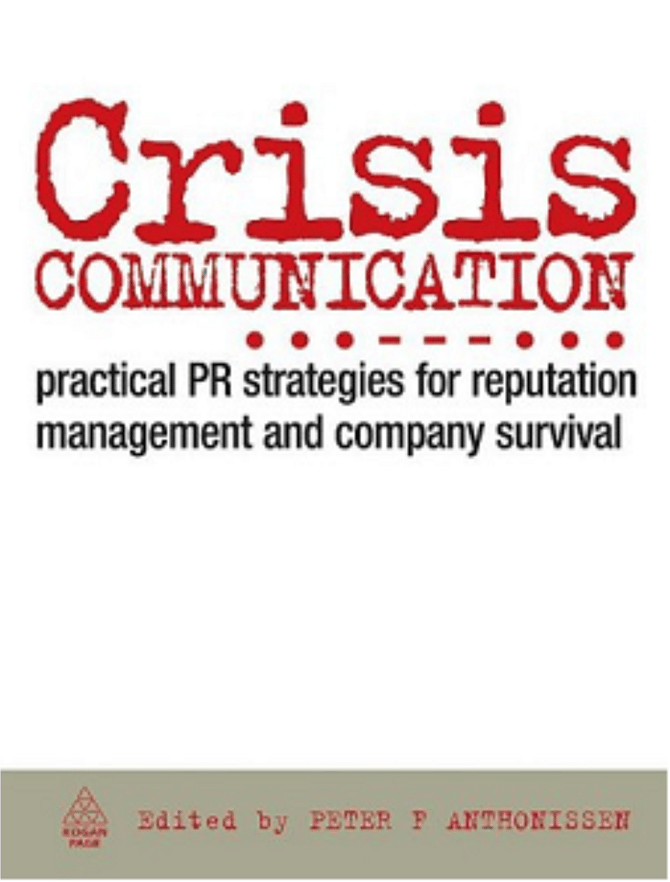
crisis Communication practical PR Strategies for Reputation Management
Contents
List of contributors ix
Foreword by Jim Walsh xvii
Introduction Peter Frans Anthonissen 1
1. No thrillers, but hard reality 7
Peter Frans Anthonissen
Introduction 7; There are no guarantees 9; Stakeholders
are everywhere 10; The accountability factor 10;
Annoying threats 11; Crises are challenges 13; Successful
crisis communication – principles 14; Learn lessons from
what has happened 18; A crisis for every day of the
week 18; Conclusion 23
2. Proactive crisis communication planning 24
Nick Leighton and Tony Shelton
Introduction 24; Need for a plan 25; What is a crisis? 25;
What a crisis plan provides 28; Elements of a plan 28;
People 28; The plan 33; Conclusion 43
3. Image as a part of corporate strategy 44
Tom Gable
Introduction 44; Reputations add value over time 45;
Determining how you want to be known 46; Establishing
competitive advantage 46; Communicating what you
stand for 47; Planning to reach all potential audiences 48;
Turning vision into reality 48; Tell real stories 49; Appeal
to higher standards, bigger ideas 50; Conclusion 54
v
4. Calamities 55
Jerry Hendin, Silvia Pendás de Cassina and Jim Walsh
Introduction 55; Aeroplane accidents 56; Natural
disasters 59; Being prepared: Alaska Airlines 261 60;
When fire strikes – twice 66; Conclusion 71
5. The new dynamics of financial crisis 73
Tim Wallace
Introduction 73; Understanding financial crisis 74;
Institutional investors: potential agents of crisis 77;
Responding to financial crisis 79; Conclusion 86
6. Fraud 88
Thom M Serafin
Introduction 88; Gather the facts 89; Legal issues must be
sorted out 90; Third-party validation 91; Delay and
denial compound the problem 92; When your client is a
victim of fraud 93; Implementing an action plan 95;
Conclusion 96
7. Reorganization and restructuring 97
Kathryn Tunheim, Marianne de Bruijn and Jim Walsh
Introduction 97; Swiss purchase of US financial services
company 98; Moving business from The Netherlands to
Germany 100; Goodwill is vital in a closure situation 103;
Conclusion 108
8. A multitude of challenges for the international
food sector 109
Mania Xenou and Nuria Sánchez
Food safety 110; Health and diet issues 111; Crisis
preparation is the key to success 111; Stakeholders 112;
The need for proactive communication 113;
The media 113; Conclusion 114; Case study 114
9. Negative press and how to deal with it 119
Elizabeth Seigenthaler Courtney and Willem Buitelaar
Introduction 119; Prepare early and often 120; Mitigate
impact with proactive response 121; Detecting a negative
story before it appears 123; No ostriches need apply 124;
Building bridges toward recovery 126; Conclusion 126;
Case study 127
vi Contents
10. There is no substitute for media training 132
Nick Leighton, Steven Pellegrino and Tony Shelton
Introduction 132; Who should we train? 133; Who should
do the training? 134; Other resources 135; Who are the
media? 136; Developing the crisis message 137; Know the
rules of the game 138; Conducting the training 140;
Conclusion 141
11. How senior management can make the crisis worse 142
Stuart Hyslop
Introduction 142; How it can all go wrong 142; Managing
to make it worse 143; Getting it right 144; How to
demonstrate leadership 146; Avoidance is endemic 148;
The danger signs 149; Conclusion 150
12. Judgement days 152
Kathryn Tunheim
Introduction 152; Case study 153; Conclusion 156
13. Environmental crisis communications 157
Robert J Oltmanns
Introduction 157; Laying the groundwork: creating a
culture of environmental stewardship 159; When a crisis
hits 163; Conclusion 168
14. Crisis communication and the net 169
Roger Bridgeman
Introduction 169; The nature of the net… fast, expansive,
inclusive and a great leveller 170; New medium, new
risks 171; The power to empower a crisis 172; New tools,
new opportunities 173; The new ground rules 174; Crisis
communications – engagement versus
pronouncements 176; Conclusion 177
15. Organizational barriers to crisis and public affairs
management 178
Roger Bridgeman
Introduction 178; Dismissing the issue, marginalizing the
opposition 179; Averting a crisis by early action 180;
Corporate resources can’t trump a crisis 181; Responding
to a crisis with real process change 182; Assuming a quick
fix will make the problem go away 183; Confusing facts
with perception 184; Combating the corporate siege
mentality 185; Conclusion 186
Contentsvii
16. Risk managers 187
Odile Vernier
Introduction 187; When brands do not measure up to
public opinion 188; ‘Social autism’ 189; Turning public
opinion into an asset 189; The brand – its financial and
social implications 190; Risks, risk managers and crisis
communication 191; Company governance: a new source
of crises 195; Conclusion 196
17. Crisis communication checklists 197
Peter Frans Anthonissen
1. Preparations 197; 2. Public groups and
stakeholders 198; 3. Crisis centre 199; 4. What’s in your
crisis-communication survival kit? 200; 5. Background
information 201; 6. Employee training: dealing with the
media 202; 7. Crisis manual 202; 8. How to handle a
crisis 203; 9. Crisis strategy 204; 10. Crisis
communication 206
Appendices
1. Factual information document 207
2. Message development document 210
3. Crisis preparation document 213
4. Special considerations for dealing with reporters in a crisis 216
Bibliography 217
Index 218
 Cart
Cart  Checkout
Checkout